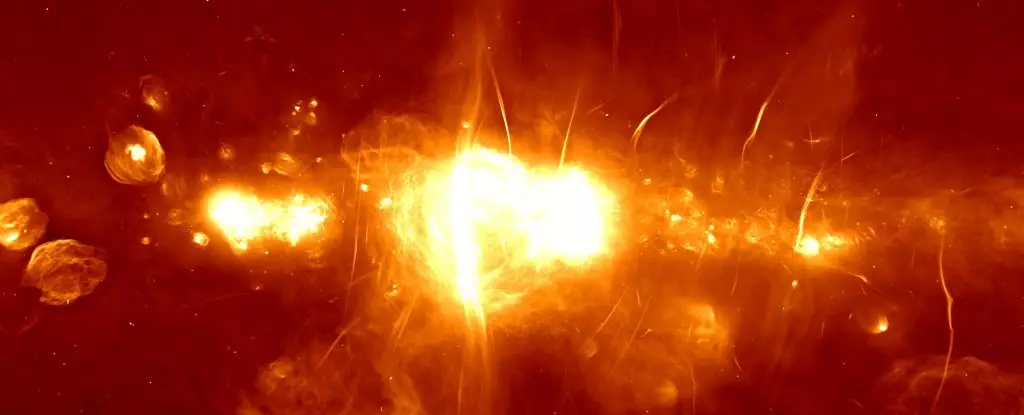At the heart of our Milky Way galaxy lies a tumultuous environment known as the Central Molecular Zone (CMZ), a region that has perplexed astronomers for years. This area is saturated with dense clouds of molecular gas and dust, presenting an intricate and dynamic scene that rivals any natural wonder on Earth. Measuring an immense 2,000 light-years across, the CMZ accounts for nearly 80% of the galaxy’s dense gas. Within this chaotic region, gas clouds zip through space at remarkable speeds—up to 100 kilometers per second—creating shock fronts and an unpredictable atmosphere that can severely impede our observational efforts.
To navigate this swirling chaos, a team of astronomers led by Kai Yang of Shanghai Jiao Tong University turned to the Atacama Large Millimeter/submillimeter Array (ALMA) in Chile, utilizing its advanced capabilities to probe this enigmatic region. Their objective was to understand the processes governing gas dynamics within the CMZ by studying silicon monoxide, a molecule that can indicate shock processes. What they discovered not only altered their expectations but also provided new insights into how material circulates through the galaxy.
The Discovery of Slim Filaments: Unexpected Cosmic Structures
The observations unveiled strikingly long and slender filaments of gas unlike anything previously documented in the CMZ. Dubbed “slim filaments,” these structures present a unique profile, replete with a variety of complex organic molecules such as cyclopropenylidene, formaldehyde, cyanoacetylene, and methanol. This diverse molecular composition hints at a dynamic environment where chemical reactions are actively transforming gas into a multitude of organic compounds.
Yang’s team noted that these slim filaments are spatially offset from star-forming regions, which is particularly intriguing. It suggests that the mechanisms behind their formation might be more complex than mere gravitational attraction to stellar nurseries. Instead, they appear to be shaped by turbulence and shock interactions within the CMZ, establishing a novel category of cosmic structures that may play a role similar to terrestrial tornadoes or dust devils.
Crisis and Creation: Turbulence as a Driving Force
One of the most intriguing aspects of slim filaments is their turbulent nature, characterized by velocity distributions that differ from those of other known filaments. Rather than a stable flow, these slender structures are dominated by turbulent pressure, indicating that they exist in a transient state—briefly forming and then dissipating as they interact with their environment. This transitory quality positions slim filaments as dynamic components in the cycling of interstellar material.
The process of formation for slim filaments remains shrouded in mystery. However, the research team posits that shock waves generated by collisions within the dense clouds of the CMZ catalyze their creation. As these shock waves pass through the gas, they heat could ignite chemical reactions, further enriching the interstellar medium with diverse organic compounds. Upon cooling, these substances can transition back into solid dust, thus contributing to the necessary recycling of material within the CMZ, a phenomenon essential for the galaxy’s long-term health and development.
A Paradigm Shift: Rethinking Galactic Dynamics
The implications of this discovery extend far beyond just enhancing our understanding of the CMZ. The identification of slim filaments as significant players in the galactic material circulation signals a paradigm shift in astronomers’ comprehension of gas dynamics. They highlight the need to reassess various models concerning star formation and the lifecycle of interstellar materials. Furthermore, if these structures are indeed widespread within the CMZ, they could play a crucial role in refining the current understanding of mass distribution and chemical enrichment throughout the galaxy.
As astronomers delve deeper into the cosmos, the potential for new discoveries looms ever larger. The CMZ, with its complex interplay of gas, dust, and dynamic turbulence, is a testament to the unpredictable nature of our universe. With each new finding, like the slim filaments revealed by Yang and his team, we inch closer to painting a comprehensive picture of our galactic home—a place where chaos breeds creativity, and every spark of discovery illuminates the dark paths of the cosmos. Such insights remind us that the universe is replete with mysteries just waiting to be unveiled, encouraging a continual quest for knowledge and understanding beyond our planet.

